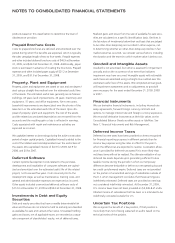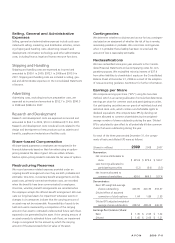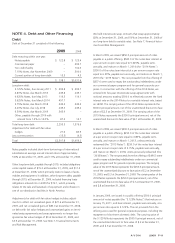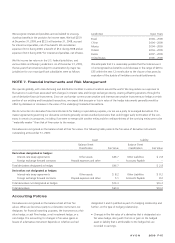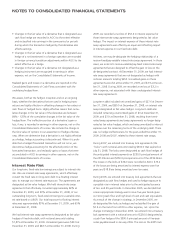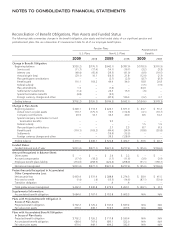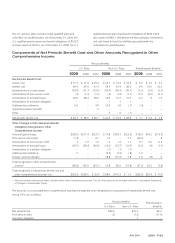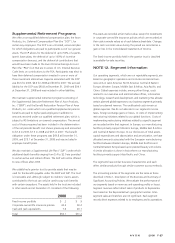Avon 2009 Annual Report Download - page 81
Download and view the complete annual report
Please find page 81 of the 2009 Avon annual report below. You can navigate through the pages in the report by either clicking on the pages listed below, or by using the keyword search tool below to find specific information within the annual report.
agreement of $1.9 was recorded in AOCI and is being amortized
to interest expense over five years.
During 2003, we entered into treasury lock agreements that we
designated as cash flow hedges and used to hedge the exposure
to the possible rise in interest rates prior to the issuance of the
4.625% Notes. The loss of $2.6 was recorded in AOCI and is
being amortized to interest expense over ten years.
AOCI included remaining unamortized losses of $28.8 ($18.7 net
of taxes) at December 31, 2009, and $35.2 ($22.9 net of taxes)
at December 31, 2008, resulting from treasury lock agreements.
Foreign Currency Risk
The primary currencies forwhich we have net underlying foreign
currencyexchange rate exposures are theArgentine peso, Brazilian
real, British pound, Canadian dollar, Chinese renminbi, Colombian
peso, theeuro, Japanese yen, Mexican peso, Philippine peso, Polish
zloty, Russian ruble, Turkish lira, Ukrainian hryvnia and Venezuelan
bolivar. We use foreign exchange forward contracts to manage a
portion of our foreign currency exchange rate exposures. At
December 31, 2009, we had outstanding foreign exchange forward
contracts with notional amounts totaling approximately $285.2 for
the euro, the Hungarian forint, thePeruvian new sol, the Czech
Republickoruna, theRomanian leu, theCanadian dollar, the
Australian dollar, the NewZealand dollar, the Polish zloty and the
British pound.
We use foreign exchange forward contracts to hedge portions
of our forecasted foreign currency cash flows resulting from
intercompany royalties, and other third-party and intercompany
foreign currency transactions where there is ahigh probability
that anticipated exposures will materialize. These contracts have
been designated as cash flow hedges. The effective portion of
the gain or loss on the derivative is recorded in accumulated
other comprehensive income to the extent effective and reclas-
sified into earnings in the same period or periods during which
the transaction hedged by that derivative also affects earnings.
The ineffective portion of the gain or loss on the derivative is
recorded in other expense, net. The ineffective portion of our
cash flow foreign currency derivative instruments and the net
gains or losses reclassified from AOCI to earnings for cash flow
hedges that had been discontinued because the forecasted
transactions were not probable of occurring were not material.
As of December 31, 2009, we expect to reclassify $18.8, net of
taxes, of net losses on derivative instruments designated as cash
flow hedges from AOCI to earnings during the next 12 months
due to (a) foreign currency denominated intercompany royalties,
(b) intercompany loan settlements and (c) foreign currency
denominated purchases or receipts.
For the years ended December 31, 2009 and 2008, cash flow
hedges impacted AOCI as follows:
2009 2008
Net derivative losses at beginning of year,
net of taxes of $14.8 and $9.7 $(27.2) $(17.7)
Net gains on derivative instruments,
net of taxes of $2.4 and $8.4 31.0 20.3
Reclassification of net gains to earnings,
net of taxes of $7.1 and $3.3 (22.6) (29.8)
Net derivative losses at end of year,
net of taxes of $10.1 and $14.8 $(18.8) $(27.2)
We also use foreign exchange forward contracts to manage for-
eign currency exposure of intercompany loans. These contracts
are not designated as hedges for financial reporting purposes.
The change in fair value of these contracts is immediately recog-
nized in earnings and substantially offsets the foreign currency
impact recognized in earnings relating to the intercompany
loans. During 2009, we recorded again of $8.3 in other
expense, net related to these undesignated foreign exchange
forward contracts. Also during 2009, we recorded aloss of $2.9
related to the intercompany loans, caused by changes in foreign
currency exchange rates.
We have used foreign exchange forward contracts and foreign
currency-denominated debt to hedge the foreign currency
exposure related to the net assets of aforeign subsidiary. Aloss
of $1.6 on the foreign currency-denominated debt was effective
as ahedge of the net assets of the foreign subsidiary and was
recorded in accumulated other comprehensive income. During
2009, we had aJapanese yen-denominated note payable to
hedge our net investment in our Japanese subsidiary. This debt
was repaid in 2009. $23.8 for 2009, $33.6 for 2008 and $9.7
for 2007, related to the effective portions of these hedges were
included in foreign currency translation adjustments within AOCI
on the Consolidated Balance Sheets. During 2009, the ineffec-
tive portion of the loss was $.3 on the foreign currency-denom-
inated debt and was recorded in other expense, net.
Credit and Market Risk
We attempt to minimize our credit exposure to counterparties by
entering into interest rate swap and foreign currency forward
rate and option agreements only with major international finan-
cial institutions with “A” or higher credit ratings as issued by
Standard &Poor’s Corporation. Our foreign currency and inter-
est rate derivatives are comprised of over-the-counter forward
contracts, swaps or options with major international financial
institutions. Although our theoretical credit risk is the replace-
ment cost at the then estimated fair value of these instruments,
AVON2009 F-17



